Shuri Castle
-Shuri Castle -400 year capital of southern island kingdom-
Overview
Name: Shuri castle /Syuri castle (Shuri-jo/Syuri-jo))
Alias:
Place: Shuri-Kinjo-cho Naha city, Okinawa
Location: 26.217329521177977, 127.71987629006851
Type: Hill Castle
Built: Originally in 14th century, expanded in 15th century
Remaining remnants: Stone walls
Title: 100 famous Japanese castles, World heritage (collectively with other Okinawa castles)
Shuri castle (首里城) is located at the south edge of Shuri height in the eastern part of current Naha city. In the south half of Okinawa island, long height of about 100 meter high passes north and south ward at the middle of island, which is separated into pieces by crossing rivers. Large castles in the middle part of Okinawa castle such as Nakagusuku castle or Urasoe castle were built using the edge of this height, and this is also applicable to Shuri castle.
Especially the sight of Shuri castle is protected by the deep valley of Asatogawa river and Makabigawa river which merges at the west of the castle, with a good width of flat land can be used for the residence of retainers and castle town. Furthermore, Shuri area is just 2 kilometer apart from Naha area, which condition is suitable for a port, being a gulf protected by surrounding land and considerably large flat land in Okinawa island.
Precise year is unknown but Shuri castle was first built in 14th century, probably as a small fort. Before the establishment of Ryukyu Kingdom at the beginning of 15th century, Okinawa island was divided into three kingdoms.
The first is Hokuzan Kingdom which held north half of Okinawa island and resided at Nakijin castle, and the second was Chuzan Kingdom that reigned from current Yomitan and Uruma to Naha and located at Urasoe castle. The last was Nanzan Kingdom, which kept southern end of Okinawa island under Kokubagawa river and lived at Ozato castle. First Shuri castle might be the border fort of Chuzan Kingdom toward south.
Sho Hashi (1372-1439), the virtual founder of Ryukyu Kingdom (precisely First Sho Dynasty), was originally a local lord of Sashiki castle under Nanzan Kingdom. In 1406, Sho Hashi marched to weakened Chuzan Kingdom and beat it, then opened Ryukyu Kingdom and placed his father as the first King. At this time Sho Hashi abolished Urasoe castle and chose Shuri castle as a new main base. In addition to good condition described above, Shuri area was at the middle of former Chuzan Kingdom territory and his original land.
Sho Hashi next ruined Hokuzan Kingdom and Nanzan Kingdom in 20 years then united whole Okinawa island in 1429. Sho Hashi expanded Shuri castle as a capital of unified Kingdom, and also developed Naha port as a trading port with China and Japan. But after the death of Sho Hashi, short lived kings continued and the power of the Kingdom gradually weakened.
In the middle of 15th century, the Kingdom barely suppressed rebellion of two strong lord Gosamaru (?-1458) at Nakagusuku castle and Anawari (?-1458) at Katsuren castle, but this also meant lost of supporter of Sho Clan in case of emergency. At last, first Sho House was extinguished by the coup d'?tat of Kanamaru (1415-1476), former chancellor of Kingdom in 1469. Shuri castle was involved in such political conflicts and lost but restored each time.
Kanamaru who seized hegemony used the surname of Sho, then his house is called as Second Sho Dynasty). At the time of his grandson Sho Shin (1465-1527), Ryukyu Kingdom captured Yaeyama islands or Yonaguni island and expanded their territory into whole Ryukyu islands. Sho Shin promoted maritime trade between China, Japan and Southeast Asian countries, and also forced local lords to live near Shuri castle. Shuri castle was further expanded, then Naha port and Shuri castle prospered as a capital of Kingdom and main port.
The main body of Shuri castle spreads over elliptical shaped hill of 400 meter long and 200 meter width continues east and west ward. Roughly Shuri castle consist of two layer of stone walls, with an inner area like a shape of a ship and outer area surrounds north, east and south side of inner area.
Palace of the King is built over eastern half of inner area. At the center of inner area, the main building called as "Seiden", front gate and attached side building used for administrative space are built at each line of square shaped stone paved space, connected by corridor. This is a traditional style of Chinese or Japanese palace and temples, along with the usage of red color.
The main building is a 30 meter long and 20 meter wide palace of four stories, and used as a place of audience of King or official event. The throne room is decorated by frame of Chinese Character and sculpture of dragon, clearly affected by the way of China. But behind this official space there are spaces for private use, which consist of simple wood and tatami carpet, totally same to the house of mainland Japan. Western half of inner area is a large flat space used for garden or training space.
Outer wall surrounds eastern half of inner area might be added in 16th century, considering unstable situation of surrounding area. Different from buildings, stone walls of Shuri castle is built under the way of Traditional Okinawa castle. The height of outer wall is taller than inner one and beautifully waved, both for decorative purpose and military purpose to erase dead angle. Also by connecting outer gate and inner gate with narrow path and steep steps, both of authority of inner area and defense ability improved.
Ahead of Kankaimon gate, the main gate of outer wall, there is a main route of the castle toward Naha port. Just ahead of the Kankaimon gate, there is Shureinomon gate (Shureimon gate) which was the main gate of the castle from outside.
The origin of the name is a frame of Chinese character hangs at the top of gate, which describes "Shurei no Kuni (Kingdom of courtesy). This gate is a Chinese style four pillar gate with no door, decorated with colorful roofing blocks. Furthermore, ahead of Shureinomon, there is a tomb of King family named "Tamaudon".
Throughout 16th century, Ryukyu Kingdom nominally subordinated to Chinese Ming dynasty and prospered based on foreign trades. But along with the decline of Ming Dynasty, official privileged trade with China did not bring profit than ever.
Beside, arrival of European nation to East Asia region and progress of navigation enabled direct treading between China, Japan and East Asian countries passing Ryukyu Kingdom. Furthermore, in 16th century, Japanese Edo Shogunate and Chinese Qin Dynasty both strictly controlled foreign trade only at approved port.
Among the change of circumstance, in 1609, Shimazu clan which was the lord of Satsuma province (Kagoshima prefecture) attacked Ryukyu kingdom and let them to be a vassal state of Japan. Ryukyu Kingdom nominally continued and still paid the tribute to China throughout Edo era, but among the complex foreign relationship, finally in 1879 Ryukyu Kingdom lost its sovereign and formally became the part of Japan. At this time Shuri castle also ceased to be a capital of Okinawa island over 400 years after the commencement.
After that Shuri castle was used as a military base or schools, but totally burnt down during the fierce battle at World War 2 in 1945. Recently reconstruction of buildings is gradually proceeding, and good part of former palaces are already restored. Beside this, ruin of Shuri castle was nominated as a world heritage along with other Okinawa castles such as Nakagusuku castle or Nakijin castle. Red building and white stone wall shines in blue sky is exactly a tropical symbol of Okinawa island, and hope this restored castle remain long time as a part of Japanese castles.
Important notice
On October 2019, reconstructed main buildings of the castle were lost by fire.
10 minutes walk from Okinawa City Monorail (Yui-Rail) Shuri station. 10 minutes drive from Okinawa Expressway Naha interchange.
Nakagusuku Castle -Last and strongest medieal fortress in Okinawa-
Nakijin Castle -Magnificent castle of northern kingdom of Okinawa island-
Katsuren Castle -Castle of talented lord who aimed whole Okinawa island-
Type: Hill Castle
Built: Originally in 14th century, expanded in 15th century
Remaining remnants: Stone walls
Title: 100 famous Japanese castles, World heritage (collectively with other Okinawa castles)
Brief History
Shuri castle (首里城) is located at the south edge of Shuri height in the eastern part of current Naha city. In the south half of Okinawa island, long height of about 100 meter high passes north and south ward at the middle of island, which is separated into pieces by crossing rivers. Large castles in the middle part of Okinawa castle such as Nakagusuku castle or Urasoe castle were built using the edge of this height, and this is also applicable to Shuri castle.
Especially the sight of Shuri castle is protected by the deep valley of Asatogawa river and Makabigawa river which merges at the west of the castle, with a good width of flat land can be used for the residence of retainers and castle town. Furthermore, Shuri area is just 2 kilometer apart from Naha area, which condition is suitable for a port, being a gulf protected by surrounding land and considerably large flat land in Okinawa island.
Origin of Shuri castle
Precise year is unknown but Shuri castle was first built in 14th century, probably as a small fort. Before the establishment of Ryukyu Kingdom at the beginning of 15th century, Okinawa island was divided into three kingdoms.
The first is Hokuzan Kingdom which held north half of Okinawa island and resided at Nakijin castle, and the second was Chuzan Kingdom that reigned from current Yomitan and Uruma to Naha and located at Urasoe castle. The last was Nanzan Kingdom, which kept southern end of Okinawa island under Kokubagawa river and lived at Ozato castle. First Shuri castle might be the border fort of Chuzan Kingdom toward south.
Sho Hashi (1372-1439), the virtual founder of Ryukyu Kingdom (precisely First Sho Dynasty), was originally a local lord of Sashiki castle under Nanzan Kingdom. In 1406, Sho Hashi marched to weakened Chuzan Kingdom and beat it, then opened Ryukyu Kingdom and placed his father as the first King. At this time Sho Hashi abolished Urasoe castle and chose Shuri castle as a new main base. In addition to good condition described above, Shuri area was at the middle of former Chuzan Kingdom territory and his original land.
Transition of Sho Dynasties
Sho Hashi next ruined Hokuzan Kingdom and Nanzan Kingdom in 20 years then united whole Okinawa island in 1429. Sho Hashi expanded Shuri castle as a capital of unified Kingdom, and also developed Naha port as a trading port with China and Japan. But after the death of Sho Hashi, short lived kings continued and the power of the Kingdom gradually weakened.
In the middle of 15th century, the Kingdom barely suppressed rebellion of two strong lord Gosamaru (?-1458) at Nakagusuku castle and Anawari (?-1458) at Katsuren castle, but this also meant lost of supporter of Sho Clan in case of emergency. At last, first Sho House was extinguished by the coup d'?tat of Kanamaru (1415-1476), former chancellor of Kingdom in 1469. Shuri castle was involved in such political conflicts and lost but restored each time.
Kanamaru who seized hegemony used the surname of Sho, then his house is called as Second Sho Dynasty). At the time of his grandson Sho Shin (1465-1527), Ryukyu Kingdom captured Yaeyama islands or Yonaguni island and expanded their territory into whole Ryukyu islands. Sho Shin promoted maritime trade between China, Japan and Southeast Asian countries, and also forced local lords to live near Shuri castle. Shuri castle was further expanded, then Naha port and Shuri castle prospered as a capital of Kingdom and main port.
Structure of Shuri castle
The main body of Shuri castle spreads over elliptical shaped hill of 400 meter long and 200 meter width continues east and west ward. Roughly Shuri castle consist of two layer of stone walls, with an inner area like a shape of a ship and outer area surrounds north, east and south side of inner area.
Palace of the King is built over eastern half of inner area. At the center of inner area, the main building called as "Seiden", front gate and attached side building used for administrative space are built at each line of square shaped stone paved space, connected by corridor. This is a traditional style of Chinese or Japanese palace and temples, along with the usage of red color.
The main building is a 30 meter long and 20 meter wide palace of four stories, and used as a place of audience of King or official event. The throne room is decorated by frame of Chinese Character and sculpture of dragon, clearly affected by the way of China. But behind this official space there are spaces for private use, which consist of simple wood and tatami carpet, totally same to the house of mainland Japan. Western half of inner area is a large flat space used for garden or training space.
Outer area of castle
Outer wall surrounds eastern half of inner area might be added in 16th century, considering unstable situation of surrounding area. Different from buildings, stone walls of Shuri castle is built under the way of Traditional Okinawa castle. The height of outer wall is taller than inner one and beautifully waved, both for decorative purpose and military purpose to erase dead angle. Also by connecting outer gate and inner gate with narrow path and steep steps, both of authority of inner area and defense ability improved.
Ahead of Kankaimon gate, the main gate of outer wall, there is a main route of the castle toward Naha port. Just ahead of the Kankaimon gate, there is Shureinomon gate (Shureimon gate) which was the main gate of the castle from outside.
The origin of the name is a frame of Chinese character hangs at the top of gate, which describes "Shurei no Kuni (Kingdom of courtesy). This gate is a Chinese style four pillar gate with no door, decorated with colorful roofing blocks. Furthermore, ahead of Shureinomon, there is a tomb of King family named "Tamaudon".
Fate of southern island kingdom
Throughout 16th century, Ryukyu Kingdom nominally subordinated to Chinese Ming dynasty and prospered based on foreign trades. But along with the decline of Ming Dynasty, official privileged trade with China did not bring profit than ever.
Beside, arrival of European nation to East Asia region and progress of navigation enabled direct treading between China, Japan and East Asian countries passing Ryukyu Kingdom. Furthermore, in 16th century, Japanese Edo Shogunate and Chinese Qin Dynasty both strictly controlled foreign trade only at approved port.
Among the change of circumstance, in 1609, Shimazu clan which was the lord of Satsuma province (Kagoshima prefecture) attacked Ryukyu kingdom and let them to be a vassal state of Japan. Ryukyu Kingdom nominally continued and still paid the tribute to China throughout Edo era, but among the complex foreign relationship, finally in 1879 Ryukyu Kingdom lost its sovereign and formally became the part of Japan. At this time Shuri castle also ceased to be a capital of Okinawa island over 400 years after the commencement.
Afterward of castle
After that Shuri castle was used as a military base or schools, but totally burnt down during the fierce battle at World War 2 in 1945. Recently reconstruction of buildings is gradually proceeding, and good part of former palaces are already restored. Beside this, ruin of Shuri castle was nominated as a world heritage along with other Okinawa castles such as Nakagusuku castle or Nakijin castle. Red building and white stone wall shines in blue sky is exactly a tropical symbol of Okinawa island, and hope this restored castle remain long time as a part of Japanese castles.
Important notice
On October 2019, reconstructed main buildings of the castle were lost by fire.
Access
10 minutes walk from Okinawa City Monorail (Yui-Rail) Shuri station. 10 minutes drive from Okinawa Expressway Naha interchange.
Related Castles
Nakagusuku Castle -Last and strongest medieal fortress in Okinawa-
Nakijin Castle -Magnificent castle of northern kingdom of Okinawa island-
Katsuren Castle -Castle of talented lord who aimed whole Okinawa island-




























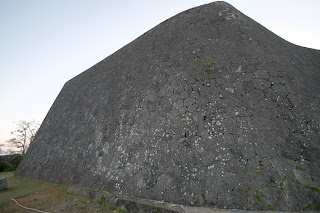











































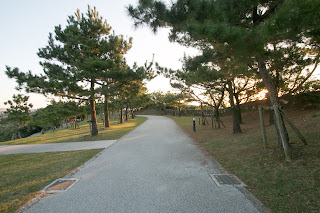


























































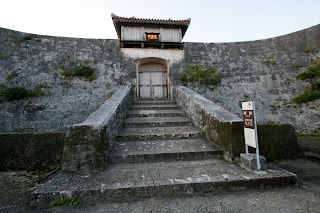



















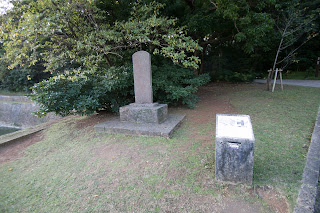





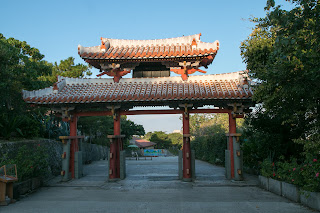































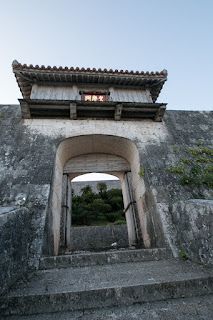
























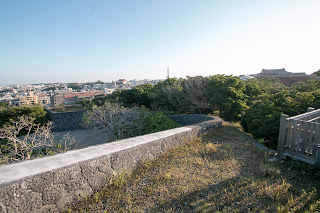


















































No comments:
Post a Comment